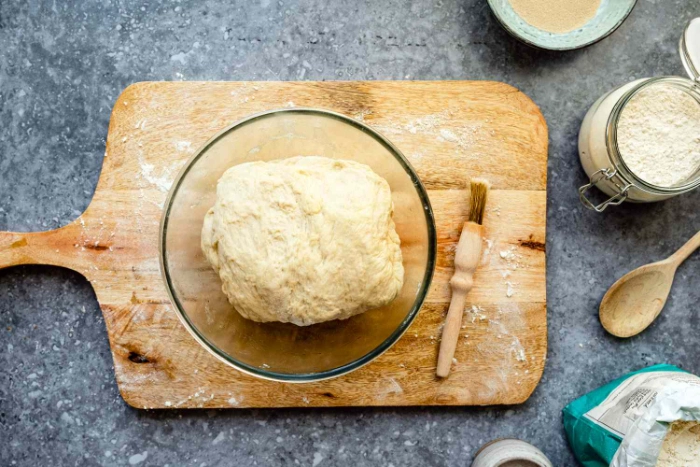Folding Dough: Why It Matters and How to Do It Right

-
Why Is Folding Dough Important?
-
Stretch and Fold Method
- How to Stretch and Fold:
-
Coil Fold Method (Best for Sourdough)
- How to Coil Fold:
-
How Many Times Should You Fold Dough?
-
FAQs About Folding Dough
- What happens if you don’t stretch and fold dough?
- Can I stretch and fold after bulk fermentation?
- What’s the difference between coil fold vs. stretch and fold?
- When should I stop folding sourdough?
-
Final Thoughts
-
Other posts that you might like:
Folding dough is a crucial step in bread baking, especially for sourdough and other artisanal loaves. It helps strengthen the gluten network, evenly distribute air pockets, and improve the dough’s structure. This technique enhances both the texture and the final rise of your bread. If you’re working with a homemade sourdough starter, proper folding is essential for getting the most out of your naturally fermented dough.
In this guide, we’ll explore the two main folding methods - coil fold and stretch and fold - and when to use each. Whether you're making no-knead sourdough or perfecting boule bread shaping, understanding dough folding is essential.
Why Is Folding Dough Important?
Folding helps build gluten structure, which is essential for the dough to trap gas during fermentation. It also helps distribute yeast and fermentation byproducts evenly, leading to a more uniform crumb. Additionally, proper folding enhances dough elasticity and strength, making shaping easier and improving the final loaf’s rise.
Folding is particularly useful in bulk fermentation, where it allows gentle handling without overworking the dough. If you've ever wondered "Can you stretch and fold sourdough too much?", the answer is yes - overhandling can deflate the dough, so knowing the right technique is key.
If you’re making sourdough from scratch, keep in mind that your sourdough starter plays a key role in fermentation. A well-maintained starter leads to a more active dough, which responds better to folding techniques.
Stretch and Fold Method
The stretch and fold technique is ideal for high-hydration doughs, such as ciabatta or focaccia. It gently develops gluten without kneading and is particularly effective for bulk fermentation pizza dough or sourdough bread.
How to Stretch and Fold:
Wet your hands to prevent sticking and gently release the dough from the bowl.
Grab one edge of the dough, lift it, and stretch it upwards without tearing.
Fold it over itself.
Rotate the bowl 90 degrees and repeat for all four sides.
Cover and let rest for 30-45 minutes before repeating if needed.
This method is great for incorporating mix-ins like nuts, seeds, or dried fruit!
Coil Fold Method (Best for Sourdough)
The coil fold technique is commonly used for high-hydration sourdough to create an airy, open crumb. It’s gentler than stretch and fold and keeps the dough’s bubbles intact.
How to Coil Fold:
Wet your hands to prevent sticking and gently release the dough from the bowl.
Gently lift the dough from underneath.
Let gravity stretch it down naturally.
Fold one-third of the dough under itself, then rotate the bowl 180° and repeat.
Turn the bowl 90 degrees and repeat the folding motion again.
Rest the dough and repeat after 30-45 minutes as needed.
Coil folds are especially useful during bulk fermentation, preventing overhandling while strengthening the dough.
How Many Times Should You Fold Dough?
For most recipes, 3 to 5 rounds of folding during bulk fermentation is ideal. Over-folding can result in a dense loaf, so it's best to observe your dough.
A good rule of thumb:
For sourdough bread, aim for 3-5 coil folds. Depending on the state of the dough.
For pizza dough, 2-3 stretches and folds should be sufficient.
If using a long cold bulk fermentation, fewer folds are needed since time does the work.
If you're making homemade sourdough bread, the folding process works in tandem with the fermentation time. Adjust the number of folds based on how your dough develops - your sourdough starter’s activity level and room temperature can influence this.
FAQs About Folding Dough
What happens if you don’t stretch and fold dough?
Your dough may be weak, leading to a dense, flat loaf with a poor, uneven structure.
Can I stretch and fold after bulk fermentation?
I strongly advise against it. The folding happens during bulk fermentation to develop structure before final shaping. After shaping there is no point.
What’s the difference between coil fold vs. stretch and fold?
Coil folds are gentler and better for high-hydration dough.
Stretch and fold provide more tension, making it ideal for slightly firmer doughs.
When should I stop folding sourdough?
When the dough holds its shape well, shows enough elasticity, and looks airy, typically after 3-5 rounds of folding.
Final Thoughts
Mastering dough folding techniques is an essential skill for any home baker. Whether you're making no-knead sourdough or shaping the perfect boule, understanding when and how to fold will take your baking to the next level.
Try these techniques in your next bake and enjoy a stronger dough, better oven spring, and a beautiful, airy crumb!
Other posts that you might like:
How to Make Homemade Sourdough Bread: A Beginner’s Guide
How to Make a Sourdough Starter from Scratch: A Foolproof Guide
-
Why Is Folding Dough Important?
-
Stretch and Fold Method
- How to Stretch and Fold:
-
Coil Fold Method (Best for Sourdough)
- How to Coil Fold:
-
How Many Times Should You Fold Dough?
-
FAQs About Folding Dough
- What happens if you don’t stretch and fold dough?
- Can I stretch and fold after bulk fermentation?
- What’s the difference between coil fold vs. stretch and fold?
- When should I stop folding sourdough?
-
Final Thoughts
-
Other posts that you might like:
